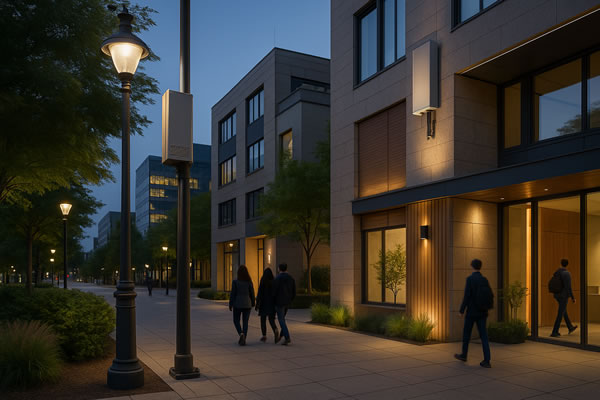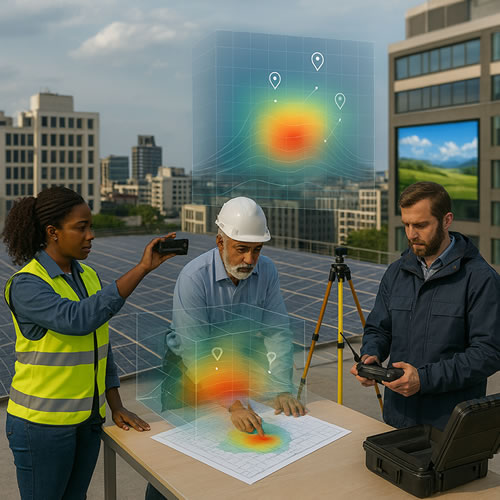Cel-Fi vs Wi-Fi 7: Understanding the Key Differences in Wireless Connectivity

In an era where reliable connectivity enables us to do just about everything, it’s easy to get confused by the proliferation of wireless technologies available today. Two you may’ve heard rumblings about lately are Cel-Fi and Wi-Fi 7 but despite their similar names, they’re intended to accomplish very different things. This manual explains what each technology does, the pros and cons of each and how to choose which best fits your business or property. What is Cel-Fi? Cel-Fi is a cell signal booster designed to improve mobile signal inside. It picks up a weak mobile signal from the nearest network mast, amplifies it and redistributes it around your building. Cel-Fi systems are particularly useful where mobile reception is spotty, rural locations, large buildings with solid walls, or underground structures. Advantages of Cel-Fi Boosts mobile signal: Strengthens weak cellular signals from operators like EE, O2, Three and Vodafone. Disadvantages of Cel-Fi What is Wi-Fi 7? Wi-Fi 7 is the latest generation of wireless internet technology. It is also referred to as IEEE 802.11be. It’s designed to provide extremely high speed and lower latency on a local network. It is quite ideal for applications that require high bandwidth, including video calling, streaming, online gaming and smart building applications. Benefits of Wi-Fi 7 Downsides of Wi-Fi 7 Cel-Fi vs Wi-Fi 7: What Should You Use? It simply matters what kind of connectivity problem you’re solving: Choose Cel-Fi if you’re experiencing weak or patchy mobile reception within. It’s the ideal solution for delivering seamless voice calls, texts and mobile data coverage across your building. Choose Wi-Fi 7 if you require higher internet speeds, reduced latency and better performance for your home, warehouse, or office network. In others, they complement each other — Cel-Fi keeps your mobile devices in touch with the network and Wi-Fi 7 delivers high-speed localised access to the internet. Need Help Choosing the Right Solution? We create and deploy solid connectivity solutions to diverse industries including healthcare and education, utilities, defence and transport. Whatever you need, whether it is better mobile coverage with Cel-Fi or at the cutting edge of Wi-Fi performance with Wi-Fi 7, our experts can consult and install the solution you need for your site. Contact us today to discuss your requirements and receive the optimum connection solution for your company.
What is Wi-Fi 7

Wi-Fi has come a long way since the slow, patchy connections that’d drop out at the very worst time. With each successive generation, Wi-Fi has become faster, more consistent and capable of handling more devices at once. Now, Wi-Fi 7 is here and it will transform the way we connect in the office and at home. But what is Wi-Fi 7 and why do you need to care? Let’s take it apart. What Is Wi-Fi 7? Wi-Fi 7, also officially referred to as IEEE 802.11be, is the new wireless networking standard, the successor to Wi-Fi 6 and Wi-Fi 6E. It’s designed to provide greater speeds, less latency and more efficient performance, even in settings where many devices are connected at the same time. In simple terms, Wi-Fi 7 accelerates your internet speed, smoothens it and makes it more stable — perfect for offices, schools and smart homes of today that need uninterrupted connectivity. How Fast Is Wi-Fi 7? Wi-Fi 7 is a whippy one — as fast as 46 Gbps under ideal conditions. That’s roughly four times the speed of Wi-Fi 6. While you might not see those speeds in real-world use, you should be able to notice significantly faster file transfers, higher quality video streaming and more fluid video calls. That makes Wi-Fi 7 perfect for 4K and 8K video, AR/VR uses, cloud computing and hybrid offices that rely on good wireless networks. What’s New in Wi-Fi 7? Wi-Fi 7 brings some essential improvements over the past generations: Larger channels (up to 320 MHz): More bandwidth means more data can be transferred at once — like increasing lanes on a highway. Multi-Link Operation (MLO): Devices can send and receive data on multiple frequency bands simultaneously, improving speed and dependability. Lower latency: Essential for real-time applications such as video calling, online gaming and IoT networks. Better performance in crowded areas: Offices, campuses and event spaces with dozens of connected devices will see fewer delays. Why Wi-Fi 7 Matters for Businesses For businesses, Wi-Fi 7 is not just about speed — it’s about performance and productivity. Business environments today are constructed upon cloud services, video conferencing and wireless collaboration software. A high-capacity, efficient network keeps everything humming. Businesses can expect with Wi-Fi 7: If your company is struggling with dropped connections or sluggish network speeds, upgrading to Wi-Fi 7 may be the solution you’ve been looking for. Why We Can Help Rapid Wireless is a leader in end-to-end enterprise-class wireless connectivity — installation and network planning through performance tuning and ongoing support. Whether you’re looking to future-proof your business with Wi-Fi 7 or integrate it alongside existing systems, our expert team can help create a solution that’s fast, secure and built to last. Stay Ahead with Smarter Connectivity Wi-Fi 7 represents the next step in wireless innovation — faster, more stable and ready for the future of connected technology. If you’re ready to experience next-generation performance, get in touch with us to discuss how Wi-Fi 7 can transform your network.
How to Boost Mobile Signal in Your Office

We’ve all been there… you’re on an important call and the signal drops out just as you’re about to make your point. Or maybe you’ve noticed that certain areas of your office are complete dead zones where mobile data barely works. Poor indoor signal isn’t just annoying; it slows down work, disrupts communication and frustrates both staff and clients. No matter if your office is in the heart of the city or out in the rural areas, weak mobile signals are more common than you would expect but the good news is they can be reversed. Why Does My Office Have a Weak Mobile Signal? There are certain reasons why mobile signal strength can be weakened indoors: If you’re taking a call by the window or venturing outside, it’s a good sign your office requires a specialist mobile signal solution. Quick Fixes You Can Try Before spending money on a more permanent solution, it’s worth experimenting with: These can be temporary fixes, but for most firms, they don’t solve the problem, especially if more than one network or large buildings are concerned. The Best Solution: A Cel-Fi Mobile Signal Booster Here at Rapid Wireless, we use Cel-Fi mobile signal boosters, Ofcom-approved technology to amplify in-building mobile coverage safely and legally. Why it’s so good: Unlike the cheaper, unapproved repeaters, Cel-Fi products are network-safe and UK regulation compliant. They are compatible with all major mobile networks and can significantly enhance voice quality and data speeds. Why Businesses Choose Rapid Wireless We don’t just sell kit – we design, install and maintain bespoke mobile signal solutions for your building and business needs. Our engineers carry out painstaking site surveys to identify weak spots and provide full coverage, whether for a small office or tall building. The Returns You Can Expect Ready to Fix Your Office Signal Problems? Bid farewell to dropped calls and slow data. Quick Wireless can help you redevelop your mobile coverage with a professional, compliant solution that delivers. Call now to book a site survey and find out how we can boost your office mobile signal.
Why You Shouldn’t DIY Your Network Mapping

Having Problems with Network Mapping? Here’s Why Professional Help Makes All the Difference Network mapping is one of those crucial but overlooked parts of putting together a reliable wireless network. Whether for a large site, a warehouse, or campus environment, understanding how your network operates and where it is deficient is the key to providing seamless connectivity. But if you’ve ever tried to do network mapping yourself, you’ll know it’s not as simple as walking around with a laptop or Wi-Fi analyser. Why Network Mapping Can Be Tricky At first glance, network mapping might seem straightforward — identify where your access points (APs) are, check the signal strength, and note where the connection drops. However, in reality, several complex factors affect network performance: Material and construction: Metal frames, glass, and even walls can absorb or reflect signals and cause weak spots. Interference: Other wireless equipment, devices, or even adjacent networks may cause interference. Overlapping coverage: Inadequate planning causes areas to have excessive signal overlap and some areas no coverage. Frequency planning: Careful channel and frequency choice are important to avoid congestion and excessive speeds. Even with the specialist software tools, correct interpretation of results and conversion into a reliable deployment plan calls for technical know-how and experience. Why Professional Network Mapping is Worth It Engaging the services of a wireless expert can save time, money and stress. Professional network mapping involves using specialist equipment and software to analyse all facets of your wireless environment — signal strength, data throughput and interference patterns. Our engineers at Rapid Wireless utilise advanced survey gear to: The result? A high-performing, fault-tolerant network underpinning your business needs — whether that’s seamless Wi-Fi for users and visitors, secure connectivity for IoT devices, or high-quality mobile signal coverage across your estate. How We Can Help We are aware that every site is unique. That’s why our wireless network design and mapping service starts with a consultation to discuss your requirements and then proceed with on-site or remote surveys using the latest technology. From there, we provide: Our team works across industries including education, healthcare, manufacturing, transport and government, ensuring reliable connectivity even in challenging environments. Ready to See the Full Picture? If you’re struggling to map your network or unsure where to start, we’re here to help. Contact us today to arrange a professional network mapping survey and take the guesswork out of your connectivity.
Choosing Between Monopoles and Traditional Towers: Which Mast Is Right for Your Project?

Choosing the right mast for your wireless setup is more than a game of height, it’s a balancing act of cost, aesthetics, install time and future capability. We guide businesses through this choice every day at Rapid Wireless. Here, we’ll examine the main differences between slimline monopoles and conventional lattice towers, so you can make the correct choice on your next deployment. 1. Appearance & Footprint Monopoles have a straightforward, cylindrical appearance and occupy minimal ground space, making them ideal for car parks, campuses and residential estates where ground is limited but appearance matters. Lattice towers occupy more ground for their base and guy wires but could look quite well-at-home in industrial estates or out in rural areas where an open-steel construction with substance is standard. 2. Height & Coverage Needs If your installation calls for heights in excess of 25 metres to hop over humps of ground or achieve greatest-area coverage, lattice towers can have modular components stacked economically to 30 metres and more. Monopoles usually peak at around 20–25 metres but still provide excellent performance for town-centre connections, car-park applications and small-cell installations. 3. Up-Front Cost vs Installation Speed Monopoles tend to be prefabricated in neat sections and can therefore be lifted and bolted on within a few days, with minimal disruption to civil works. While their per-metre material cost may be higher, the rapid installation schedule helps many clients maintain tight schedules. Traditional towers tend to involve more guy-wire anchoring or welding on-site, and this can extend build programmes but their steel-per-metre is often lower for very high heights. 4. Planning & Compliance Local authorities often prefer the discreet outline of monopoles in conservation areas or town centres, where a lattice tower may initiate protracted heritage or environmental studies. On greenfield or industrial land, a lattice tower typically glides through planning more easily, particularly where height is at issue. Our people deal with each application and engage with Ofcom and local authorities to gain permission in your name. 5. Future Expansion & Upkeep An open-frame lattice mast structure enables easy addition of antennas, dishes or even sharing common capacity with other operators in the future. Monopoles are readily strengthened or replaced in segments, but significant capacity increases at times require a complete mast replacement. With our SLAs and modular masts, Rapid Wireless assures your chosen structure adapts as your coverage requirements change. Whatever your taste, simple lines and efficient streamlining of a monopole, or flexibility of height of a lattice mast, opting for the best structure at the outset saves you time, money and planning trouble. End-to-end mast solutions from Rapid Wireless, from site survey and structural design through to planning approval and turnkey installation are tailored to your project goals. Ready to select the perfect mast for your site? Contact Rapid Wireless today to discuss your requirements and get a free, no-obligation quote:Call us: 0151 282 1800 or Email us: [email protected]
How we Safely and Efficiently Decommission a Radio Site

Shutting down a radio site is simple enough, but without a formal process, it can lead to safety risks, regulatory difficulties and surprise cost. At Rapid Wireless, we’ve refined a broad-level decommissioning plan that safeguards people, saves the environment and guarantees you’re in complete compliance but without revealing every operational detail. Here’s an overview of our process. 1. Strategic Planning & Regulatory Liaison Our project team develops a tailored decommissioning strategy prior to initial cable cut. We coordinate with Ofcom and local authorities to verify licence surrender and land-use approvals, and maintain stakeholders throughout. This early coordination eliminates costly delays and a seamless regulatory exit. 2. Health, Safety & Environmental Controls Safety first. Our engineers conduct a swift risk assessment to highlight potential dangers, ranging from working at height to standing over batteries and cables. We bring in trained personnel with safety kit, disconnecting live equipment and following industry optimum safety procedure. At the same time, environmental safeguards such as spill-containment systems protect sensitive terrain and wildlife. 3. Equipment Isolation & Removal With authority and safety protocols, technical personnel down transmitters, sever feed lines and remove antennas, cabling and mounting hardware in a stepwise fashion. Though we can’t publish each technical detail, precision tooling and step-by-step checklists minimise the potential for damage to reusable items or the adjacent infrastructure. 4. Secure Asset Handling & Responsible Disposal We carefully detail equipment to be refurbished or redeployed, optimising your return on investment. Anything beyond its usable life is handled by recognised recycling partners, with batteries, metals and electronic components responsibly disposed of in compliance with UK environmental law. 5. Site Restoration & Handover Once the gear has been removed, we restore the area to the agreed condition, whether that is reinstalling concrete pads, reseeding ground cover or restoring control to building management. Our concise documentation package verifies all work scopes complete, licences are handed back and compliance is achieved. A seamless decommissioning of radio sites requires careful planning, stringent safety control and commitment to environmental responsibility. Rapid Wireless delivers all three, so you can Decommission legacy sites with peace of mind. Need to decommission a site?Speak to our decommissioning specialists today for a discreet, end-to-end solution: Contact Rapid Wireless today to discuss your requirements and get a free, no-obligation quote:Call us: 0151 282 1800 or Email us: [email protected]
Common Telecom Licensing Challenges and How to Overcome Them

Navigating telecom licensing can often feel like stepping through a maze. Whether you’re setting up a new wireless network, deploying infrastructure or expanding existing operations, the regulatory landscape can be complex and time-consuming. Yet, getting your telecom licences right is essential to ensure compliance, avoid penalties and keep your projects on track. Let’s talk a bit about the most common telecom licensing challenges and how to overcome them best. 1. Understanding Regulatory Requirements UK telecom regulation is intricate and in flux, making it difficult to remain current with the requirements. From Ofcom licensing for radio frequency through site installation planning permission, there are various degrees of compliance. The issue: Uncertainty as to exactly which licences apply to your specific use case, whether that’s a point-to-point connection, mobile repeater or private network. The solution: Work with a partner who has Ofcom rules by heart. At Rapid Wireless, we guide you on which licences you’ll need and guide you through the process from application to approval to guarantee full compliance at every step along the way. 2. Long Approval Processes Obtaining telecoms licenses is time-consuming, especially for new frequency applications or mass-scale rollouts. Delays cause project delays, delayed deadlines and angry stakeholders. The issue: Excessive waiting times for Ofcom consent and the danger of half-baked applications adding to delays. The solution: Proper, accurate documentation at the beginning slashes the process time by dramatically. Our experienced engineers know what regulators need and ensure that all technical requirements are documented correctly before submitting, avoiding delays to you. 3. Frequency Interference and Coordination In high-density markets or multiple-operator situations, frequency interference is a nightmare. When two systems have the same or overlapping frequencies, performance degradation and legal battle can ensue. The challenge: Obtaining clean spectrum with best network performance. The solution: Get a frequency coordination study done prior to applying for your licence. Rapid Wireless employs sophisticated modelling of coverage and interference using sophisticated tools, so your system runs smoothly and within Ofcom’s technical parameters. 4. Compliance and Monitoring Compliance doesn’t end once your licence has been awarded. Regular audits, technical revisions and equipment upgrades all must be to regulatory standards. The challenge: Having to ensure continued compliance as your technology and network change. The solution: Have a compliance management plan in place. We monitor network performance and regulatory updates for our customers at Rapid Wireless, so your systems are compliant and future-proofed without the admin burden. 5. Site Access and Local Permissions Even with the correct telecom licence in place, you can be held back if you do not have the relevant planning permission or land access agreements. The issue: Overlapping requirements amongst Ofcom, councils and landowners can create confusion and project delays. The answer: Discuss everything with all the parties upfront and let our experts take care of the communications for you. Rapid Wireless has extensive familiarity with these permissions, streamlining them to keep your project on track. How We Can Help At Rapid Wireless, we simplify telecoms licensing for UK businesses. Our end-to-end offering includes: Whether you’re launching a new private wireless connection online, increasing your infrastructure or running across several sites, our experienced team ensures your network operates legally, efficiently and without interruption. Get Professional Help with Your Telecom Licensing Telecom licensing needn’t be complicated, provided you have the right partner in your corner. Contact us today to speak with our licensing experts and discover how we can help you achieve Ofcom compliance, streamline approvals and keep your network in compliance.
Innovative Designs for Modern Telecom Sites: Balancing Function and Aesthetics

Gone are the days when telecom sites were purely functional steel towers that dominated the skyline. Today’s network deployments demand both high performance and visual harmony with their surroundings. At Rapid Wireless, our site designs balance coverage, regulatory compliance and streetscape appearance to meet your project goals. Read on to see how we merge engineering excellence with aesthetic flair, so your next deployment enhances both connectivity and community appeal. 1. Stealth Masts and Camouflage Techniques When Towers Become Trees or Lamp Posts In sensitive areas such as conservation zones, heritage districts or city centres, traditional lattice towers simply won’t fly (literally or figuratively). We employ stealth mast solutions that mimic tree silhouettes, street lamps or flagpoles, ensuring your equipment blends seamlessly into the environment. Our design process includes 3D-printed prototypes, material finish tests and stakeholder reviews to nail both form and function. 2. Small-Cell Enclosures with Style Pocket-Sized Performance, Big Visual Impact As 5G densification accelerates, small-cell nodes are popping up on street furniture and building façades. Rather than bulky boxes, our weatherproof, vandal-resistant enclosures feature minimalist lines, powder-coated colours and optional branding panels. These micro-sites pack powerful radios and antennas into discreet housings, delivering gigabit-class speeds without sacrificing local character. 3. Integrating Public Art and Community Engagement From Equipment to Attraction Why not turn cabinets and cabinets into canvases? We partner with local artists and councils to create mural-wrapped shelters and sculptural installations that house radios, batteries and backup power. This not only reduces community resistance but can even become a local talking point transforming necessary infrastructure into public art. 4. Modular, Future-Proof Designs Adaptable Platforms for Tomorrow’s Tech The pace of wireless evolution shows no signs of slowing. Our modular site frames use standardised mounting rails, quick-release brackets and plug-and-play power trunks, allowing for rapid upgrades to 5G, Private Networks or emerging 6G technologies. This “design once, evolve forever” philosophy saves time, reduces waste and protects your capital investment. 5. Sustainable and Low-Impact Installations Green Energy and Eco-Friendly Materials Modern site design must factor in environmental stewardship. We integrate solar-assisted power systems, rainwater harvesting for cabinet cooling and timber-look composite panels sourced from recycled materials. Meanwhile, low-impact groundwork techniques preserve root systems and local wildlife habitats so you meet sustainability goals without compromising network performance. Conclusion & Call to Action When function meets aesthetics, telecom sites become community assets rather than eyesores. Rapid Wireless’s innovative design portfolio from camouflaged masts and art-backed cabinets to modular 5G platforms ensures your network stands out for all the right reasons. Ready to elevate your next deployment? Contact us today to explore bespoke, beautiful and high-performance site designs.
Cyber Essentials Plus Certification Achieved

We are pleased to announce that we has successfully achieved Cyber Essentials Plus certification. Cyber Essentials is a government-backed scheme designed to help organisations guard against the most common cyber threats. The “Plus” accreditation builds on this by requiring a rigorous, independent technical audit to confirm that our systems and processes are not only in place but also effective in practice. This achievement reflects our ongoing commitment to cyber security and reinforces the measures we take to safeguard our own data, as well as the information entrusted to us by our customers and partners. In today’s digital-first world, we view cyber security as a fundamental business priority rather than an IT task. The certification highlights: We are proud of the efforts of our team in securing this accreditation and will continue to invest in robust security measures to ensure our business and yours remains protected.
Tools of the Trade: How We Conduct Expert LOS Surveys

You’ve seen it before… the team turns up, the mast goes up, the dish is aimed and everyone waits for the moment of truth. Sometimes the link lights up and everything hums along. Other times it doesn’t — a rooftop obstruction nobody expected, a patch of interference, or the wrong size antenna ordered for the job. What should have been a tidy install becomes a day of improvisation, extra hardware and annoyed stakeholders. A professional line-of-sight (LOS) survey is the best way to avoid those days. At Rapid Wireless we treat surveys as risk management, not box-ticking. The aim is simple – remove uncertainty early, give installers clear, usable guidance and prove the design will perform before equipment is ordered. The result? Faster installs, fewer re-visits and links that work first time. Start smart: desk planning that saves site time Before we ever travel to a location, we do the homework that reduces surprises on site. We review current mapping and imagery, check planning considerations and build a practical shortlist of candidate locations. That desk work rarely sounds glamorous, but it consistently means fewer site visits, shorter survey time and lower project cost. See it for real: field checks that matter Maps and models are useful, but nothing beats checking things on the ground. Our engineers validate sightlines, assess mounting and access constraints and run interference checks so decisions are based on observed conditions rather than assumptions. Those on-site observations convert uncertainty into reliable data and give installers the context they need to succeed. Model with purpose: turning data into confidence Back at the office we use the survey inputs to forecast real-world performance. This modelling gives clear visual outputs, coverage maps, clearance visuals and link assessments so antenna choices, aiming angles and cable runs are chosen on evidence not guesswork. The modelling is not a substitute for experience; it amplifies it so procurement and installers can act with confidence. Deliverables installers actually use Our reports are designed for action. Rather than long theoretical documents, clients get concise, install-ready packs: elevation visuals, photographs of potential obstructions, recommended antenna sizes and mounting heights and pragmatic mitigation options where paths are imperfect. These deliverables shorten on-site decision time, reduce risk of re-work and keep schedules on track. The common mistakes we stop before they happen Over the years we see the same causes of delay. Planning from out-of-date images, skipping on-site interference checks, ordering undersized antennas, or failing to design for safe service access. A professional LOS survey catches those issues early and gives you practical, low-cost options to resolve them before they affect the build. What we won’t publish and why that matters to you We share high-level insights so clients understand value, but we keep our detailed workflows and bespoke modelling methods private. Those processes are part of how we reliably deliver results and protecting them helps us keep delivering better outcomes for our customers. If you need tender-ready templates, sample deliverables or procurement checklists, we provide those under a gated download or secure briefing to qualified prospects. A robust LOS survey is insurance for your link. It turns guesswork into verified data, reduces on-site surprises and protects your schedule and budget. Whether you’re planning rooftop links in a dense urban centre, rural backhaul, or a private 5G campus, start with a survey that gives installers everything they need to deliver first-time success. Ready to lock down your next wireless link? Call our survey team on 0151 282 1800 or contact us via our contact form. For tender or sensitive projects we’re happy to share additional detail under NDA or in a secure briefing.

